Tien Shan - Kyrgyztan - Himmelsberge
Route 2018: Bishkek - Tsholpon Ata - Bokonbayjewo - Bishkek - (Vietnam but Thayland ...)
emails from way
Route 2017: Bishkek - Tsholpon Ata - Karakol - Bokonbayjewo - Bishkek - Dshallalabad - Arslan Bob - Tsholpon Ata - Bishkek (mar-apr)
The great master arrived finally to Tien Shan, (the Himmelsberge in german), its a very interesting region as you can see by its mixed people and nature.
 Bishkek the capitel of Kyrgyztan is a medium sized city,
it has mostly broad streets, also sometimes a bid massy here nd there as by permafrost ground and its people
the once wild Nomads. It has parks and many trees along its streets, all set in squares (blocks)
In the cities center you find the Philharmonia, which did not look so harmonic to me from outside,
more like a museum as I checked its hero gallery in the nice voyer inside.
Bishkek the capitel of Kyrgyztan is a medium sized city,
it has mostly broad streets, also sometimes a bid massy here nd there as by permafrost ground and its people
the once wild Nomads. It has parks and many trees along its streets, all set in squares (blocks)
In the cities center you find the Philharmonia, which did not look so harmonic to me from outside,
more like a museum as I checked its hero gallery in the nice voyer inside.
Outside the big square with Manas monument set in a water fountain, sourrounded by parts in green and different stone plates. Government buildings in change with all kind of headquarters, offices and the shopping centers not far from it.
People are usually friendly but sometimes confusing by some rude and rough reactions done by harsh climate and permafrost over ages. Men can be ugly but often pretend very gentle and stylish, women are soft but of good body constitution and its all a special mix of turk, russian, mongolian and chinese influence over last centuries meeting.
I understand that the permafrost ground like in many regions of northern Asia during winters does as final product the Stechschritt of russian soldiers, it is the Stechschritt against the permafrost, the try and fight against that hardship along streets and the total victory over it during summers.
I understand that these long cold winters need to bring the beauty inside, the ballette, the dance, the piruette and schwalbe. Nobody can win against russian winters not Napoleon and not Hinkel.
After first nights in Bishkek, the capitel, still covered in snow I left for Tsholpon Ata placed at the kirgisean sea by the name Yssik Kul, (160km max length and 60 km broadest stretch)
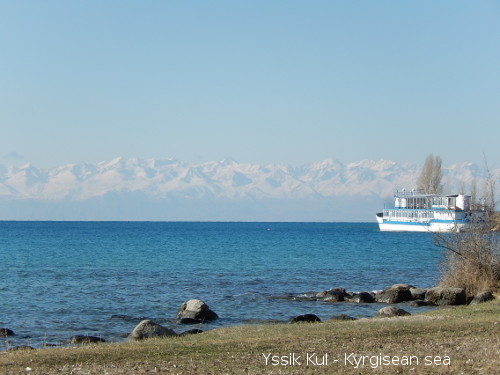 Tsholpon Ata is a tourist hotspot but unbusy and quiet during march, midnorth along Yssik Kuls shores which are totally empty during offseason. It s a perfect place to do nice late winter and spring walks over the smooth granite rock fields, crossing school pupils paths, locals and sheep up to the Petroglyphs where i found in a fully fortified area with walls and small towers some bird feathers.
Tsholpon Ata is a tourist hotspot but unbusy and quiet during march, midnorth along Yssik Kuls shores which are totally empty during offseason. It s a perfect place to do nice late winter and spring walks over the smooth granite rock fields, crossing school pupils paths, locals and sheep up to the Petroglyphs where i found in a fully fortified area with walls and small towers some bird feathers.
The Nomads are hunters till today and not only by smartphones. The feathers i found at the Petroglyphs were most possible of a Snipe which are quite rare, interesting and big birds (Solitary Snipe...) and much bigger than quales ! One time getting back to the guest house and mixing the streets from main street i got by chance into a small group of men who just got out of their car and one had a gun with him, guess for hunting. I mean in a car you can transport everything, cows, sheep, donkies, also maybe and sib. Ibex and rifles. On a scooter or motorbike you can not transport a cow or sheep, you can do shopping with a scooter and take your romance, a rifle gets risky on a bike but I ve never seen motor bikes in Kyrgyztan and thats of another system beside the dollar one and many cars, trucks, mini vans and the more. All good for transporting all from people, tourists, smoked makrels over sheep and cows to Snow Leopards.
During march the streams get covered with ice during nights yet and the way over the granite fields get crossed by a straight up to the mountains highway which is broad enough to take a russian heavy take off and lift helicopter which got also shown by a nice white circle on the highway there, which was usually unbusy during march.
It s also a good place to do nice walks down to the beaches of Yssik Kul and at the end of the day you can do some shopping or dine in the most fency restaurant of Yssik Kul area during offseason in the center of Tsholpon Ata as like in many big villages there is normally one restaurant during offseason, but that one is very stilish.
Tsholpon Ata also surprised me with a big joyce of smoked fish in one of its marcets. Smoked makrel, even some smoked salmon and some of it i kept as fish from Yssik Kul. It is the only place in Kirgistan where I found (offseason) that much variety of fish in a marcet. Yssik Kul is a bid salty but makrel gets brought from the sea, maybe in ice cube trucks i guess.

After some days i took the way eastwards as on the path of the once russian expeditions during the late 19th century east to Karakol, passing beautifull white covered winter sceneries, smooth moutain ranges and hills in snow cover.
Karakol is a wide spread town, a once russian garnison, and during winter very dirty of traffic pollution and by permafrost grounds muddy along streets. Some move there because about 12 km from town is a winter skiing resort which i did not check myself. Karakol during winter inversions is the most polluted city I ve ever been and after strange encounter with big boss from guest house and his daughter I left next day, but before i tried to visit Przsewalsky museum which should be some km north out of town as mentioned in the german travel guide book, but i was unlucky and did not get there. The travel guide book in german was that annoying allready while travelling that i took it apart some days later, its cooking recepies were too much and if the Przewalsky museum is there or just closed during winter has to be left in dark. But you can find each bigger single village in the book by its latitude-longitude, if not try a smartphone or ask a russian jet pilot on villages latitudes.
Next day i took a minibus the way along Yssik Kuls southern shores which are fantastic either during winters or summers. Hilly areas half covered in snow, streams and rivers getting down from the Tongej Alatoo range (5000 ders), apricoat orchards not yet green, some simple villages and the great Yssik Kul with its shores, small bays for summer vacation and relaxing, some half fortified Jurten camps with walls and fantasies of roaming the hills and peaks during warm season.
In Bokonbayewo i got into a nice guest house with a simple garden and exterieur which was sometimes covered in snow, also a hollywood whip but inside in contrast to the outside a nice long table for eating, couch seats covered with pillows along, guest rooms around, a hightek showercabin from China and toilet covered with woolen frame.
The big spread around village with broad streets, often covered in snow, has a main street with square, flags on masts, cars, cabs, minivas and the restaurant, also the school with big schol yard looked friendly to me but as Yssik Kul the kirgisean sea is at 1600m alt I could not reach the Snow Leopards ranges in ease, the air is thin and winds are chilling during march.
After some days i took the way back to Bishkek via the interesting Boom valley. Boom valley is a narrow V-valley as often in the breakthroughs of rivers in the Alatoo ranges. But the fascinating thing is the changes from supernarrow vallies to the far open lands totally flat which got once crossed by the Saken, the Skythen of the east, and later from east by the Mongolians and its Khan leaders later, Tshengis, Ugedej, Tulsui and more of the Khans, russian expeditions from the far northwest and Turk volks who settled here before from the mid east.
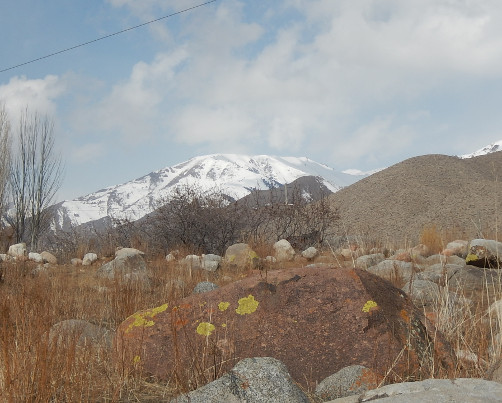 The Saken hillgraves can still be seen from even along some streetparts out in the vast lowlands and hills and i was wondering if it was family graves or for total clans and if they were made of wood which would collapse over tims or only of stones, if there were also horses and weapons buried or only people.
The Saken hillgraves can still be seen from even along some streetparts out in the vast lowlands and hills and i was wondering if it was family graves or for total clans and if they were made of wood which would collapse over tims or only of stones, if there were also horses and weapons buried or only people.
Hills changing along the way and getting sharper up to 5000 and making me nuts here and then on way before reaching the tunnel at maybe 3000m along the very broad and well kept high altitude highway. Sunset at the other side and getting down into the dark.
I was in a biotop i knew for long, sharp cliffs and ravines, but less covered in green than some vallies in Europe, here partly grown with Tien Shan Fichten and Pine trees, small avalanches showed its traces here and then on way, it was too much.
End of march Golden Eagles are sometimes passing south over the high altitude passes, often in the mist and from the highway it was even one that day not far over the pass covered in snow, some crows here and there and in a curve a flock of comon Mynas. Actual nature observations
Manas Epos
The Manas epos is mostly interesting to me, it is a Jewel of Time from the central Asian mountain steppe regions. It grabbed me at once in one night, this happens rarely with literature which catches me once in 10 years. It s the story of the Kitais, the Khans, lads, monsters, Pashas, warriors, beauties and hords.Composed in perfect rimes, a masterpiece which gives proov of the Lion Manas the overall heroe unbeatable of Tien Shan with 40 of his soldiers, who lived there once. Of the Epos:
"I did not sacrify your heads and lives
only your ears, noses and eyes ... "
Quite relevanth to modern times !
(Manas vol 1, Version by Sakymbai Orozbakov, translation by Walter May 1995)
Manas maniac below by Bars
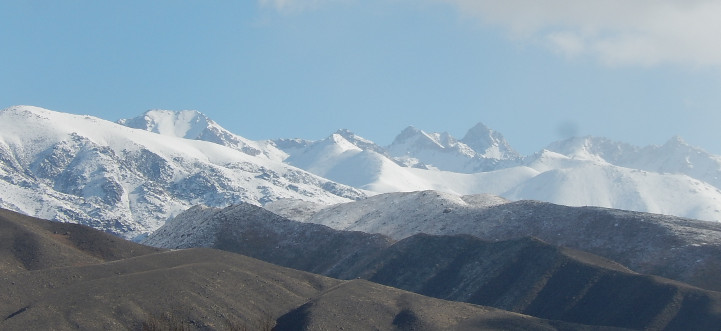
I got over the eagles ranges two times, first on way south from Bokonbayewo via Bishkek to Arslan Bob. Arrived to Dshalalabad somewhen early morning and took a simple room there. Dshalalabad is not my most liked city as in general i do not like smart.cctv or big cities alike. Even locals asked my where i got the money there later in Bishkek. Just out of any roundup ready standard ATM along main street to center in a more or less modern looking hotel or shopping center, there you find usually ATMs, but balance can normally not be chequed in foreign countries. Thats of a George Soros task and his Uni somewhere.mbb or so.
From Dshalalabad you need to take a minibus to next big village by the name Bazar Korgon, there at bus stand are also proper food shags close to the river which is rising and falling during springs in about half day timings. So all the way to Arslan Bob about 2hrs, I did sometimes hitch hiking the way to Dshalalabad cause i could not stand the roundup always ready inside music performance in some vehicles and by hitch hiking you get to know also interesting volks of a region. In the far off smart west it is then often the really brave, wicked and really smart guys, some along highways there from Algeria or Russia.
From the main not always paved street along the wide river it makes a sharp turn then up another maybe 12km to the walnut woods. At that time all was covered in snow beside parking lots and streets. I was happy and did a little walk after arriving in minibus. Asked for the guest house by the travel guide and got a quite nice room with winter garden infront, so to say the lobby to the room. Asking for key it got complicated, but 3 days later after 2 young women from the west passed by for short, somehow in mysteriouse way making holyday as the one mentioned. The first without packbag but 2 pairs of shoes ... some morning there came her friends whistled something and left, I kept thema s hippies through the glassfron to winter garden who brought her the 2nd pair of shoes. The winter garden had a woodstove connecting pipes for heating the room.
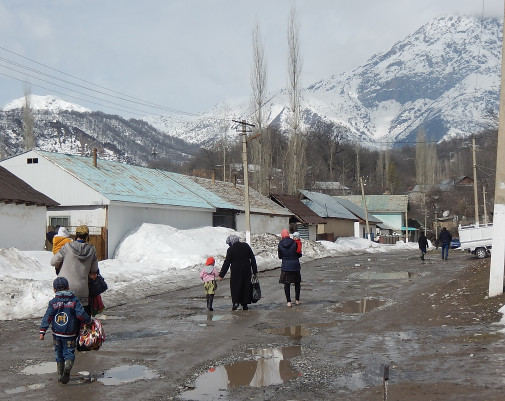
During days i did nice hikes and enjoyed fresh air, snowcovers, views and birds. People looked sometimes a bid wired to me, but also nice families here and then, some old men covered in dark long coats and caps, not to mention their boots, some were ice chopping like they had just got out of a US boot camp, but stood too close to each other while chopping with the long shovels. In the nights i was hearing them eating ice cubes beside the room. Some of the houses walls are covered by mud as wood for building is rare in the region.
The food in the village of main restaurant and its main course was mostly the same, all men there, some behind the 2 tables with curtains. Because of getting suspicious on them serving the meals with slices of horse penises and by the time it took to digest the meals, i went on taking my own eggs later, sometimes a fruit salad or coffee with cookies.
The village is embeded in the back by huge mountains, guess up to 4000, Arslan Bob is at 1500m, the way out of the valley its on the right flanked with a 4km cliffside.
At that time of the year birds chirping in spring mood, wagtails, comon mynas, once a falcon the afternoon from upper cliff range, crows, and all kind of finks.
Dshalalabad is about 2 hrs by minibus or taxi from there, changing vehicles in Bazar Korgon, it s a medium sized spread around city and has some strange railway station like looking bridges over the centers streets. Many food places some shops, but in center, worth mentioning, the big strong iron fences blocking to cross the streets. Most new houses along street don t look too old and the whole setting reminded me a bid to Pokhara lakeside (Nepal) but more popped. I did not see there a school like in Bokonbayewo with big yard, also no scooters but along the big river north of town 3 Pariah Kites and Kormorants Kyrgyztan map.
Manas Maniac
Friends of Kyrgyz and Uzbek
hold her tight before she s running off in flight
if you re coming now or late
I dont care, thats her fate
I am coming now, with the sword by the lord
Men from Tangri and Kunzum
the speaker is there
cut it apart, the system is broken
I took them hard and they got shoken
friends of Urmala and Devi
let s party and dance
after the Bars got seen, they got keen
Then is the time for drawing the spine
not in a movie, not on a horse
not in a car, but at the bar
this is mine
I take them hard
I bring the fight
not by the sword but by the word
I am the lord and see the sky
look there where I fly
I make them pay
I turn their heads and make them prey
A chicken, a monkey, a horse and a donkey
I take the chain, I make them pain
till they get slain
in the bed in the red
thats my way and now they pay
The nearest 2 hours, 6 months on feet
the furthest 35 hours, that powers
The planes are out
where is the scout
There is no traces
there is no places
There is the mushrooms, there is the plants
here is the dance, here is a chance
There is the skies, that s where i rise
I party
by Bars (Snow Leopard)
Land and people
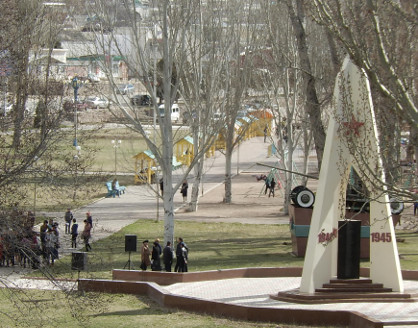 Kyrgyztan has nearly 6 mio people and exchange and mix of its people over history is very complicated.
Kyrgyztan has nearly 6 mio people and exchange and mix of its people over history is very complicated.
As during times of 2nd world war many different volks got settled by Stalin from border war zones to Kyrgyztan like the Wolga Deutschen, Tataren and Tschetschenen, not to let the people get into the hands or join the once german enemies. In between the 2 world wars enthusiastic komunists came by themself like from Tshekoslowakia and founded cities like Bishkek, once named Interhelpo. They built factories and pushed modernisation at that times.
Most dominant parts of its population are Kyrgiz, Uzbek and Kazakh volks which are all of Turk origin. Till several years ago there were uprisings and revolution like movements during the times of changes after the Sowjet Union, from komunistic to modern marcet times.
Older generations were living under more save and stable conditions of which the young today know little but seem to miss many goodies here nd there. Because of young conflicts and its mostly mixed peoples along with modern marcet conditions changing and corruption there are open wounds left and people distrust each other often.
Bishkek, the capitel, shows an interesting mix from old to modern, from founding times with industry and factories, to modern marcet with big hotels, beta stores and fency restaurants and all in between not to forget the typical huge iron monuments on big squares.
On the land you find usually most simple villages, if any at all out there in the mountain steppe where people take out their stock during summers till today. You find cities like Karakol, Osch, Dshalalabad but on the open vast land supply chain seems to be often a problem for many villages and many little goods delivered there.
People move mostly in cars, or minibuses on the land. Minibus system is like in Dom. Republic (Caribe), they ride horses till today and over long distances minivans get shared (Taxi) which are quite cheap, no scooters or motorbikes at all.
Modern kyrg. transport, I hate it when you can not open a window in modern Minicabs or cars, in Sao Paolo or Rio its much more dangerous and where it is windows can be closed.
Assimilation by AC is nonesense and unhealthy,
all that germs and dust. Sometimes it seems to be a kind of testing dusting (poisen) by AC buses, also experienced on way in Grece to Thessaloniki apr.017 (I hate Thessal.), and on way in Tanzania part about one hour before Mbeya, strange village in Steppe when new passangers enter bus onway)
Not only by flatscreens and its buttons pushed.
Stolen goods -------------- outdated -----
Kyrgyztan map / The journey went on here to India
OP marcet, Exercising great
got some strafe --- outdated -----